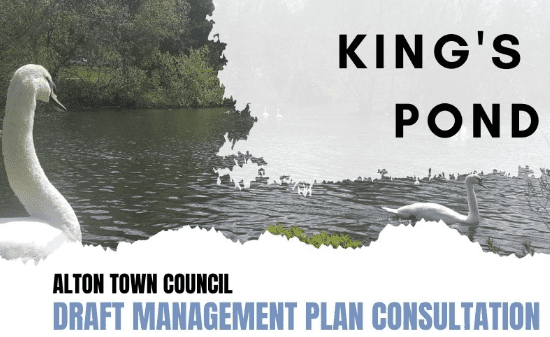AVLAN (Alton and Villages Local Action for Nature) – Alton Climate Action Network’s nature group – is calling for a respectful conversation about the future management of King’s Pond.
Dave Tickner from the group said, “AVLAN’s volunteers work with local people to protect and enhance nature. People must make up their own minds how far the health of the river Wey and having a greater diversity of wildlife in and around Kings Pond matter, compared with the beauty of the current stretch of open water with its wildfowl which families so enjoy feeding. This is a complex subject with no easy answers.”
AVLAN wants local people and visitors to enjoy King’s Pond as:
- a lovely amenity for people of all ages and abilities to enjoy.
- a healthy habitat for thriving and diverse wildlife.
- a space that isn’t going to cost a fortune to maintain.
The group sees the DRAFT King’s Pond management plan as the starting point for Alton Town Council’s intended conversation with the public about the future of Kings Pond and of the river Wey; and the balance between amenity value, biodiversity, and cost.
The drawings and artist’s impressions in the draft plan are, as AVLAN understands it, just suggestions for what could be done, not final plans. Following the public consultation, the Town Council would do a feasibility study to see what is possible and only then could the three main options of dredging, restoring the river or doing nothing be properly weighed up.
Dave Tickner said, “We want the current conversation to be informed by the best available information and expertise. There is some clear information in the draft Management Plan (especially in the annexes) that could perhaps be better presented to help the discussion.”
AVLAN’s own understanding of the available information is that –
The condition of King’s Pond and the condition of the river are intimately linked. What happens in the river upstream affects the Pond (e.g. by bringing in sediment), and what happens in the Pond affects the river downstream (e.g. by adding too many nutrients to the water). The river Wey is a precious chalk stream, a rare habitat in which Altonians take great pride and which many volunteers work hard to care for.
Kings Pond’s current value to wildlife is deceptive: the large number of water birds is sustained by the public feeding them. National studies of British ponds indicate that a good pond should have around 100 different species of invertebrates, an outstanding pond 130 species. The 2019 Kings Pond Bioblitz found only 3 species of dragonfly/damselfly (out of 28 British damselfly/dragonfly species) and it is rare to see more than one or two individuals on a summer’s walk around the pond. Damselflies and dragonflies are accurate indicators of how much animal life there is below the water. A pond the size of Kings Pond should have scores of dragonflies flitting around all summer.
Kings Pond was created by damming the river. This is disruptive to its natural processes – it accumulates pollution within the pond during summer, which is then flushed down stream in big surges when heavy rain over tops the weir. Movement of wildlife up and down the river is obstructed by the dam, causing inbreeding and preventing populations of fish from escaping drought or flood. Extreme weather conditions due to climate change, such as the severe heatwave and drought this summer, is already causing additional stress on the river and its fish.
So there are pros and cons to both options – whether it be leaving the Pond as it is, or reprofiling it into a chalk stream and separate water meadow.
- Many people love King’s Pond as it is now as a habitat for some species of wildfowl and fish. But leaving it as it is now would mean that we would lose the opportunity of having a diversity of other wildlife in this important area for nature, and it would continue to harm the health of the river Wey.
It would require dredging every ten years or so, at a cost of at least £250,000 at today’s prices (a figure which may prove to be an under-estimate as it does not include preparatory work and taking the silt off site). But without regular expensive dredging and more limits on duck feeding, both pollution of the river and the Pond and the number of rats will remain big problems.
- Restoring the river would certainly reduce the number of geese. It would also be costly initially (we don’t really know what the ongoing maintenance costs would be – the Town Council needs to try to estimate these costs). But creating many small ponds and reedbeds could create an area lovely to walk through and rich in wildlife, and the health of the river would improve.
To ensure the best possible outcome for both people and nature, AVLAN recommends that the Town Council goes ahead with commissioning a feasibility study to consider options for the future of this important amenity in more detail. The feasibility study should include the technical feasibility and costs of an option for a smaller pond, not connected to the river, with ducks for families to feed – so enjoyable for children. This would require some maintenance, but could be less expensive.
 Alton Climate Action Network
Alton Climate Action Network